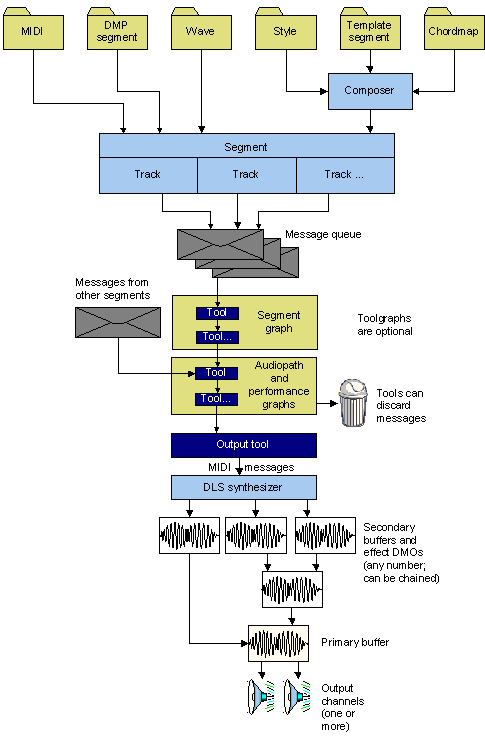
| Microsoft DirectX 9.0 |
Typically, a DirectMusic application obtains sounds from one or more of the following sources:
Note Any of these data sources can be stored in the application as a resource rather than in a separate file.
Data from these sources is encapsulated in segment objects. Each segment object represents data from a single source. At any moment in a performance, one primary segment and any number of secondary segments can be playing. Source files can be mixed; for example, a secondary segment based on a WAV file can be played along with a primary segment based on an authored segment file.
A segment comprises one or more tracks, each containing timed data of a particular kind; for example, notes or tempo changes. Most tracks generate time-stamped messages when the segment is played by the performance. Other kinds of tracks supply data only when queried by the performance.
The performance first dispatches the messages to any application-defined tools. A tool can modify a message and pass it on, delete it, or send a new message. Tools are arranged in linear sets called toolgraphs. A message might pass through any or all of the following toolgraphs, in the order given:
Finally, the messages are delivered to the output tool, which converts the data to MIDI format before passing it to the synthesizer. Channel-specific MIDI messages are directed to the appropriate channel group on the synthesizer. The synthesizer creates waveforms and streams them to a device called a sink, which manages the distribution of data through buses to DirectSound buffers.
There are three kinds of DirectSound buffers:
Note Applications are not responsible for managing secondary buffers that are part of a DirectMusic performance. Although an application can obtain a buffer object for the purpose of adding effects and changing properties, it cannot lock the buffer, write to it, start it, or stop it by using the IDirectSoundBuffer8 interface.
The following diagram is a simplified view of the flow of data from files to the speakers. A single segment is shown, though multiple segments can play at the same time. The segment gets its data from only one of the four possible sources shown: a WAV file, a MIDI file, a segment file authored in DirectMusic Producer, or component files combined by the composer object. In all cases, data can come from a resource rather than a file.

For a closer look at the flow of messages through the performance, see Using DirectMusic Messages.
For information on how to implement the process shown in the illustration, see Loading Audio Data and Playing Sounds.